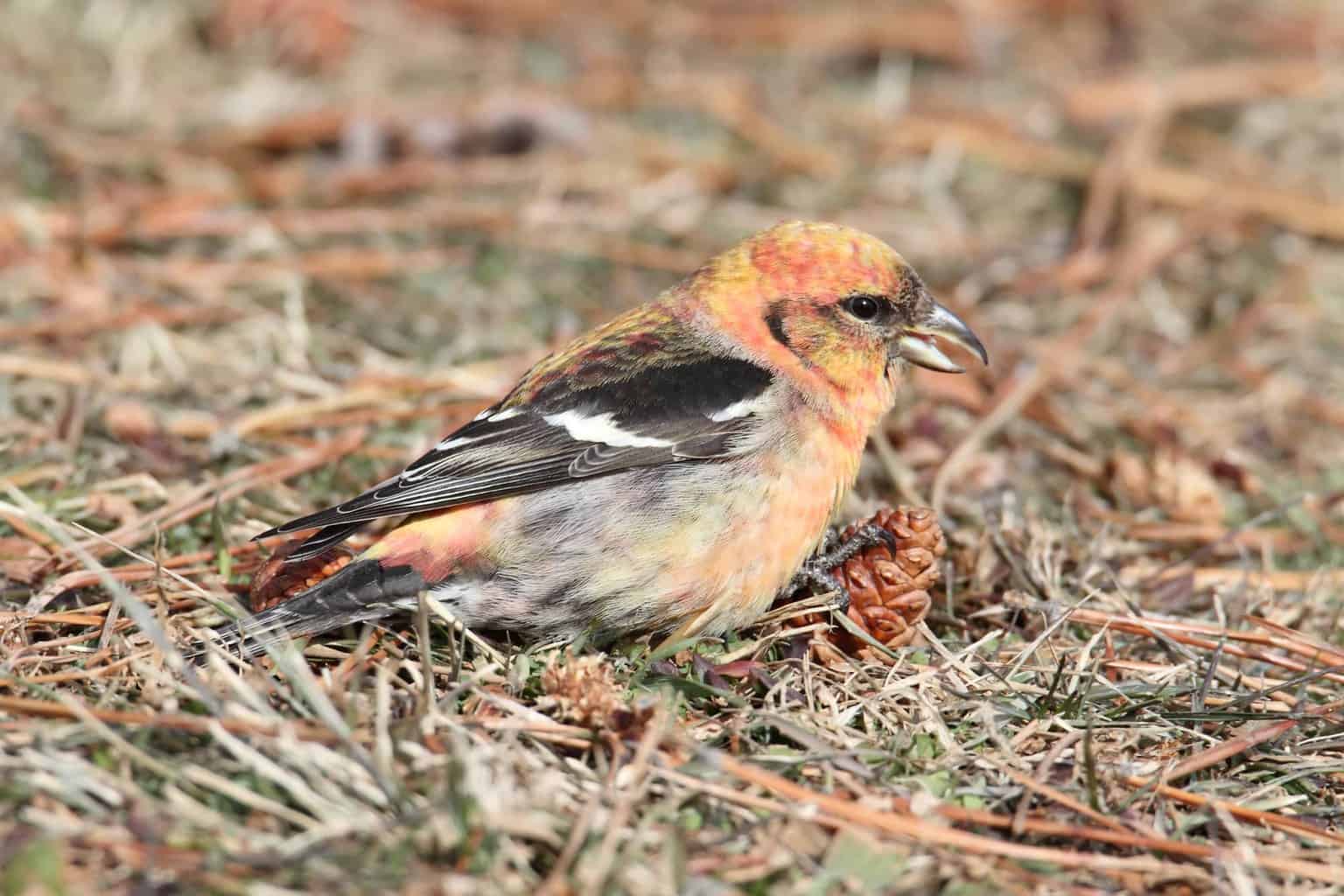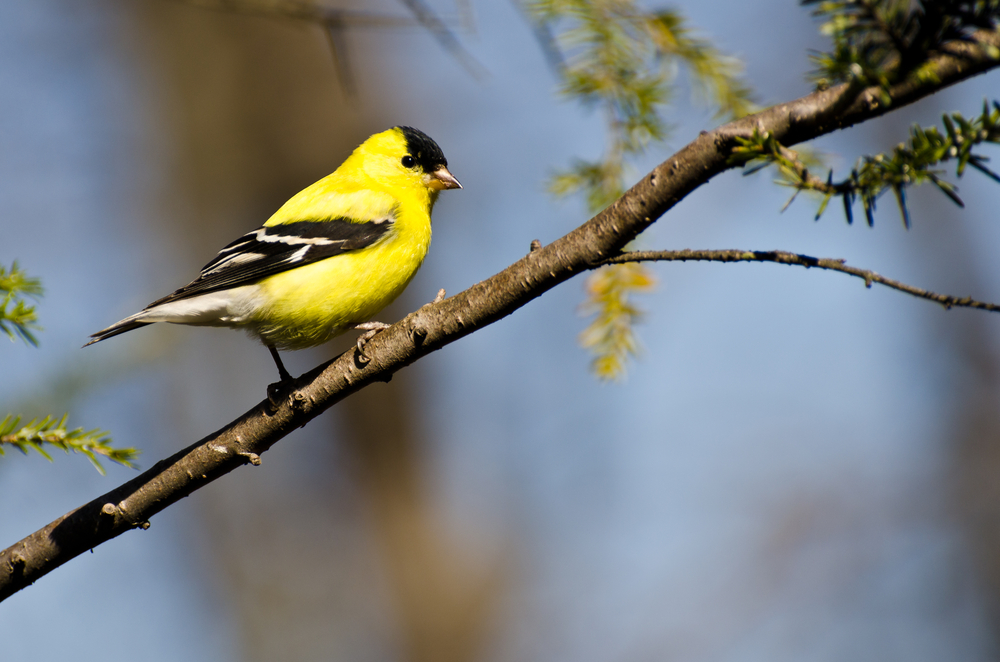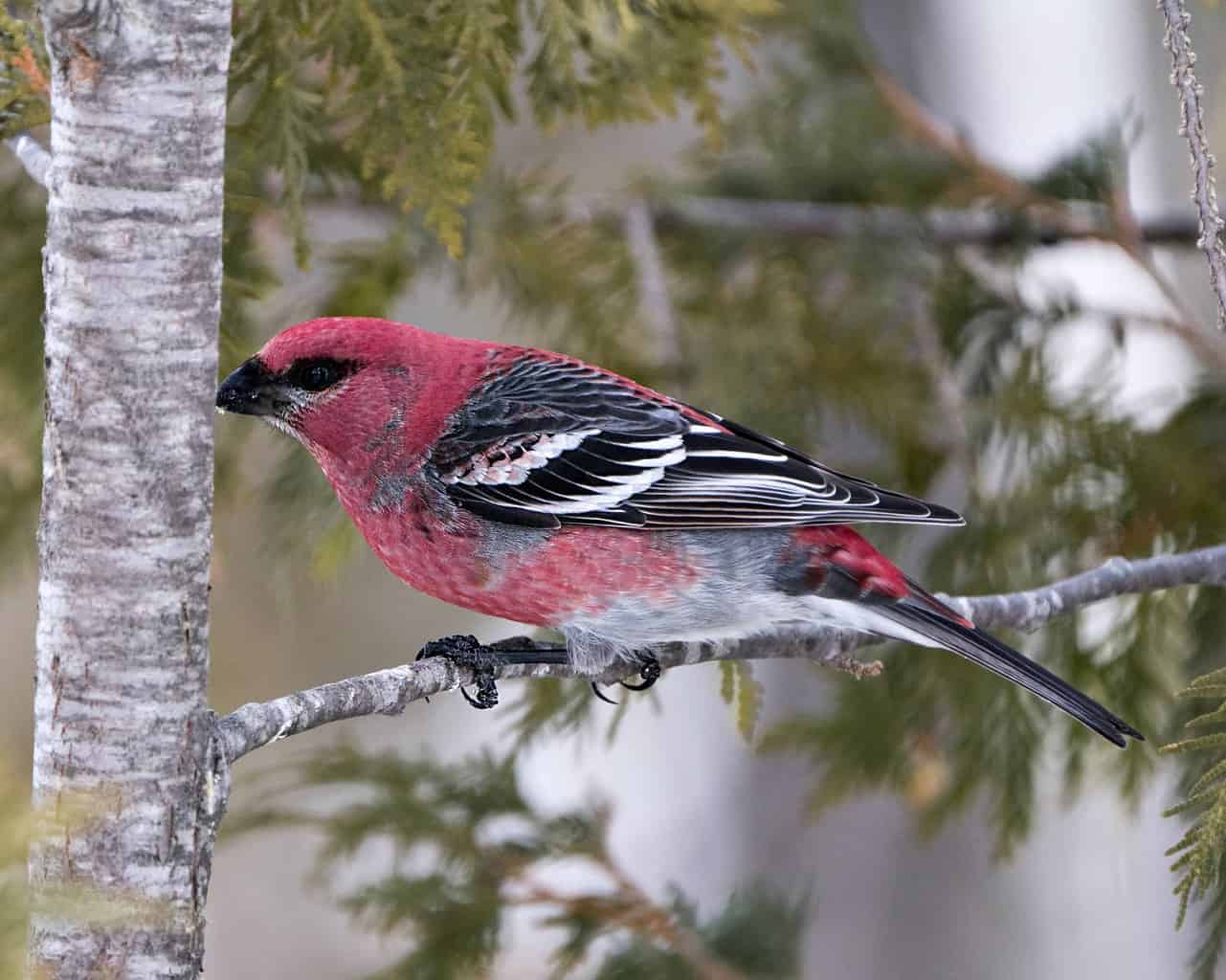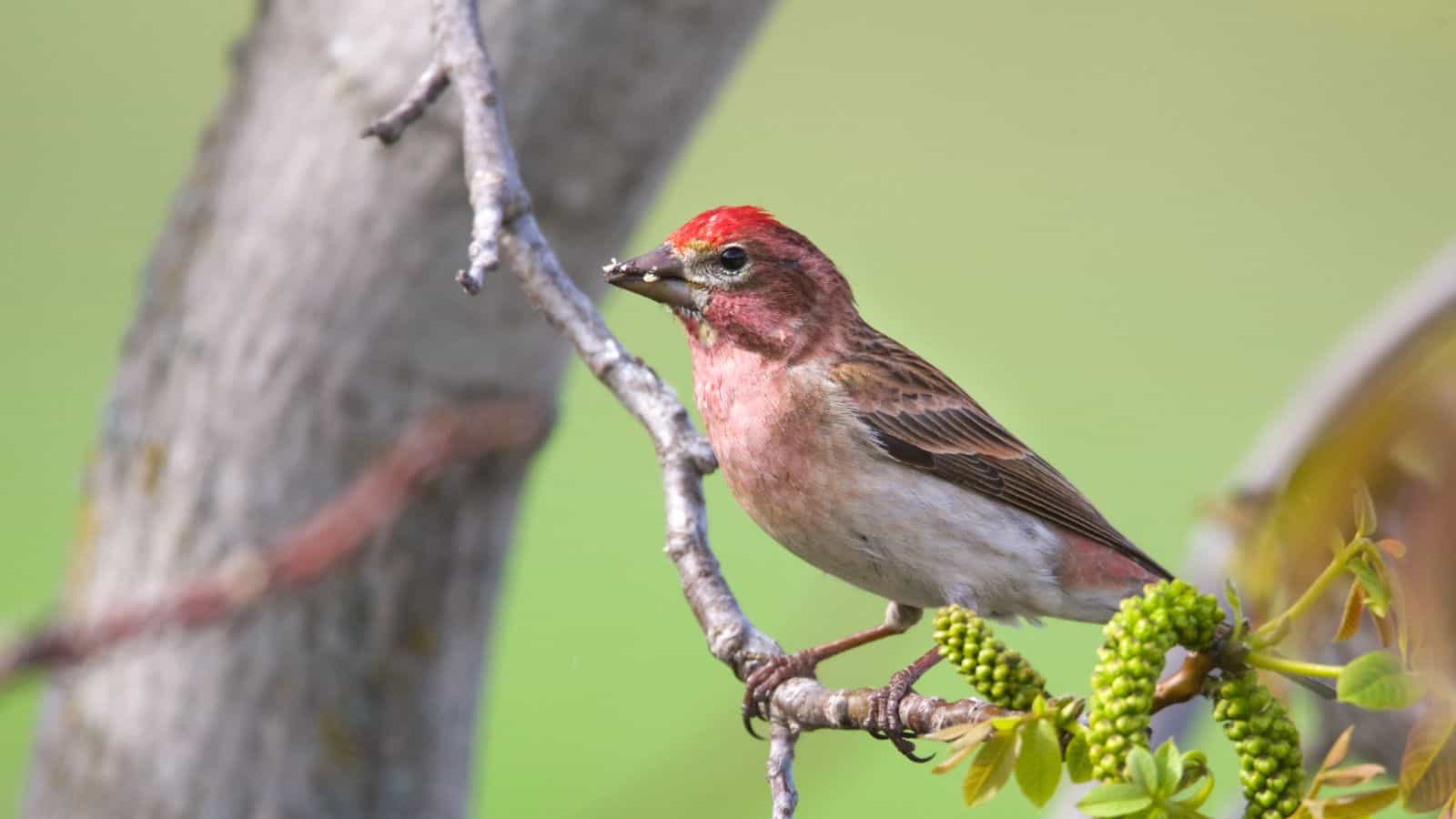Coated in misty forests and snow-capped mountains, this Pacific Northwest state is an incredibly welcoming environment to finch species. In fact, you’ll be able to spot 15 finches in Oregon!
Since many types of finches dine on seeds and flowers, Oregon’s rich forests provide them with plenty of feeding opportunities. They’re also great locations to mingle with other birds and build nests.
It’s been a while since I’ve visited Oregon, but I still have a sharp memory for its wildlife. My guide will help you spot 15 finches with mostly common species and a few rare ones.
Pine Siskin

- Species Name: Spinus pinus
- Length: 11 cm to 14 cm
- Weight: 12 grams to 18 grams
- Wingspan: 18 cm to 22 cm
Oregon is famous for its wealth of pine trees as far as the eye can see. As such, the pine siskin makes itself right at home in most of the state.
Appearance
The male pine siskin is a dusty gray and olive green with black streaks on his wings. The female pine siskin looks very similar with a little less yellow-green, though it’s hard to notice at a glance.
They both have sharply pointed beaks and smaller bodies, making them a dainty bird overall.
Range
They usually show up in western Oregon year-round and prefer eastern Oregon during their nonbreeding season. These tiny birds forage in and out of evergreen forests to find a reliable source of food.
When their usual feeding grounds are scarce, they’ll pop up in fields, gardens, and backyards.
Diet
Alder seeds and birch seeds are their favorite foods, but they’ll squeeze in the occasional flower bud. They also like to sup on nectar during the spring.
You can attract pine siskins to your feeder with unshelled sunflower seeds and nyjer seeds.
Birdsong
These vibrant birds have a rising tzweee call with short pauses in-between. They sound like their birthday just came three months early.
Fun Fact
Do you sometimes confuse finches for sparrows? While the pine siskin has a few similarities to the common sparrow, it’s more slender with olive feathers.
Red Crossbill

- Species Name: Loxia curvirostra
- Length: 14 cm to 17 cm
- Weight: 40 grams
- Wingspan: 25 to 27 cm
These birds are quite the sight with their uniquely criss-crossed beak shape. As it stands, this beak is quite helpful for them to find their major food source.
Appearance
The male red crossbill has a slightly misleading name, sometimes boasting orange-red or orange-yellow coloration. They have brown-gray wings, dark bills, and dark legs.
Female red crossbills also shake things up with hints of dusty yellow-orange. They also have more gray-brown covering their bodies.
Range
These finches are uniquely equipped to thrive in coniferous forests. They love to explore spruce, fir, and hemlock trees in search of another bite to eat.
Red crossbills are an interesting species that stays year-round in most of Oregon but rarely comes to feeders.
Diet
Conifer seeds are the red crossbill’s food of choice. You may be able to entice one or two to your feeder with fresh sunflower seeds, especially during the winter.
Birdsong
The red crossbill song is a sharp and dynamic warble that sounds like sharp breathing in-and-out.
Fun Fact
The red crossbill is very similar to the Scottish and Cassia crossbills. They’re so similar it’s hard to distinguish them on sight alone.
White-Winged Crossbill

- Species Name: Loxia leucoptera
- Length: 15 cm to 17 cm
- Weight: 24 grams to 26 grams
- Wingspan: 26 cm to 28 cm
Superficially similar to the red crossbill with their crossed beak, the white-winged crossbill is rare in Oregon. A few exceptions may linger year-round, but they’re far more common in Canada.
Appearance
The male white-winged crossbill has a bright red body with black wings and two white wing bars. They also have a dark rump and dark legs.
The female white-winged crossbill has a completely different olive-gray color. Sometimes they have a spackle of yellow on their face and neck.
Range
These birds are a rather rare sight in Oregon but may show up from time to time in heavily forested areas. Interestingly enough, they’re still more likely to show up at bird feeders than their red counterparts.
Diet
These birds are so in love with seeds you can usually hear them before you see them. While they usually devour conifer seeds all day long, they also like fresh sunflower seeds.
Birdsong
These chatty birds have a spitfire song composed of fast chee-chee-chees and chr-chr-chrs.
Fun Fact
While many finch babies will leave the nest within two weeks, these finches stick with their family for a few months.
Purple Finch

- Species Name: Haemorhous purpureus
- Length: 12 cm to 16 cm
- Weight: 18 grams to 32 grams
- Wingspan: 22 cm to 26 cm
There’s nothing quite like color contrast to bring out your inner artist. The purple finch is a glorious sight against Oregon’s rich green and orange trees.
Appearance
The male purple finch is as red as a raspberry, covered in pinkish-red with brown wings and a white rump. They have a brown-gray bill with brown-gray legs.
Female purple finches look similar to a common sparrow, but don’t be fooled! They have more streaks on their body and a distinctive white ‘eyebrow’.
Range
The purple finch has a very interesting range, showing up year-round in western Oregon but preferring to breed further east. This is definitely a bird to keep an eye out for if you plan on kayaking or sightseeing along the Oregon coast.
Diet
These birds regularly forage or flit about looking for berries, insects, and seeds. You’ll have no problem attracting them to your backyard bird feeder with fresh millet or sunflower seeds.
Birdsong
The purple finch has a sweet and joyful song, composed of rising and falling notes that often repeat.
Fun Fact
Not only do house finches look similar to purple finches, they actively compete for food.
American Goldfinch

- Species Name: Spinus tristis
- Length: 11 cm to 13 cm
- Weight: 11 grams to 20 grams
- Wingspan: 19 cm to 22 cm
Another bird that offers beautiful contrast is the American Goldfinch’s classic yellow coloration. They’re quite a sight against Oregon’s misty skies!
Appearance
The male American goldfinch is a dynamic fellow, boasting lemon yellow coloration with black wings and white wing bars. They have a little black spot on their head that looks like a cap.
However, keep in mind adult males only have this coloration during the breeding period. Their feather colors soften to an olive the rest of the year.
The female American goldfinch looks quite similar to the male outside of breeding season.
Range
These charming finches show up year-round in eastern Oregon and are more scarce in the western portion of the state. While many finches love to root around in forests, American goldfinches prefer wide, open areas.
These finches are great for beginners because of their wide ranges — expect to see these birds in meadows, plains, and orchards. They’ll also flit around forest edges.
Diet
Did you know these finches aren’t fans of insects? While they’ll eat the occasional bug, they much prefer weeds, berries, and seeds.
You can attract American goldfinches to your feeder with hearty helpings of nyjer seeds. They’re very sociable birds, too, so you’ll have a lot of fun watching them interact.
Birdsong
It’s a small wonder why the American goldfinch is so beloved. Their rich song is high-pitched and sweet with repetitive chweet-chweets or chwee-err-rees.
Fun Fact
American goldfinches have a complex set of calls depending on if they’re mating, looking for food, or protecting themselves. They make a notable bear-bee sound to warn their chicks to hide from predators.
Lesser Goldfinch

- Species Name: Spinus psaltria
- Length: 9 cm to 12 cm
- Weight: 8 grams to 11 grams
- Wingspan: 20 cm
Just how small can a finch get? The lesser goldfinch is likely the smallest true finch in the world.
Appearance
The male finch is simply adorable, boasting a black body with a bright yellow stomach and white wingbars. Coupled with their small size, they almost look like a bumblebee.
The female lesser goldfinch is a light yellow-tan with brown wings and a pale beak. You may be able to spot their more subtle white wing bars.
Range
Expect to see these finches quite commonly in western Oregon. They often head to southern portions of the state for breeding season.
They’re fond of shrubbery and forested areas, but often steer clear of dense forest. They are also quite comfortable in more urban environments such as parks and backyards.
Diet
Flower buds and seeds are their preferred foods of choice. Bird watchers easily attract these birds with fresh sunflower and nyjer seeds.
Birdsong
These finches have a bright, almost metallic note to their call. They often sing in rapid twit-twit-twits mixed with an occasional, chiming twrrr.
Fun Fact
Unlike many finches, the American Goldfinch is less territorial and doesn’t engage in territorial singing.
Pine Grosbeak

- Species Name: Pinicola enucleator
- Length: 20 cm to 25 cm
- Weight: 57 grams
- Wingspan: 33 cm
These round, heavy finches almost appear to be part of a different species. Indeed, you could confuse them for robins if you’re not careful!
Appearance
The male pine grosbeak is a husky fellow, boasting a round, red body with gray wings and white wing bars. They have a dark conical beak and dark legs.
The female pine grosbeak has entirely different coloration – her body is gray with yellow-orange on her head and rump. She also has thin white wing bars.
Range
These larger birds are more scarce than other finches on this list, but you’ll recognize them immediately due to their size. Expect to see them more commonly in northeastern Oregon.
While usually a fan of boreal forests in their day-to-day life, they sometimes crop up in coniferous forests to breed. You can usually find them foraging in trees and bushes for food.
Diet
Pine grosbeaks eat a diverse diet of berries, seeds, flower buds, and insects.
Birdsong
Their song is a rather delicate creation, composed of airy and light warbles and the occasional trill.
Fun Fact
Since these birds don’t startle easily, they’re an approachable species for beginner bird watchers.
Evening Grosbeak

- Species Name: Hesperiphona vespertina
- Length: 16 cm to 22 cm
- Weight: 38 grams to 68 grams
- Wingspan: 30 cm to 36 cm
Are you a fan of photography? The evening grosbeak’s stunning feather coloration is a must-have for your portfolio.
Appearance
The male evening grosbeak has a striking yellow body with black wings and large white wing bars. They have a bold yellow stripe on their brow that gives them a permanent scowl.
The female evening grosbeak has a light gray body with speckled black and white wings. They often have a ring of yellow around their neck.
Range
These birds are quite comfortable along the coast of Oregon and appear year-round. However, you may be able to spot them in western Oregon if you go hiking in forested areas.
Evening grosbeaks love to forage in bushes, shrubs, and trees for food. When they’re low on food, they show up in more urban environments in search for easy meals.
Diet
These finches eat everything from berries to seeds. You may be able to attract them to your feeder in the winter months if you have sunflower seeds.
Just remember to use a platform feeder – evening grosbeaks are a little too large for tube feeders.
Birdsong
Evening grosbeaks have a sharp, in-and-out call that ends in a high note. They also make chirping sounds that sound like brrr or chew-chew.
Fun Fact
Do you have a sharp eye for subtle differences? The evening grosbeak looks rather similar to the Eurasian hawfinch, especially in low light.
Blue Grosbeak

- Species Name: Passerina caerulea
- Length: 14 cm to 19 cm
- Weight: 26 grams to 31 grams
- Wingspan: 26 cm to 29 cm
What a stunning finch! The blue grosbeak is a visually romantic bird with its diverse coloration and rounded tail.
Appearance
Male blue grosbeaks are berry blue with dustings of brown and black along their wings. Their beak and legs are silvery-gray.
The female blue grosbeak has more classically subdued colors of light brown and gray. However, she’ll have a little blue-gray along her rump.
Range
These birds are very rare in Oregon, usually preferring to breed in California or Idaho. However, you may glimpse the occasional individual roaming outside its range.
Make sure to look for shrubby and overgrown fields, their favorite habitats.
Diet
Blue grosbeaks are avid foragers, constantly digging around for berries, seeds, and insects. They also eat quite a few spiders and snails.
You’re less likely to see this bird at your feeder, but backyards with lots of plants may entice them to visit.
Birdsong
This darling bird has a lilting warble composed of repetitive rising and falling notes. They sometimes shake things up with light brrs.
Fun Fact
Blue grosbeaks are commonly confused with bird species such as the indigo bunting and the blue jay.
Gray-Crowned Rosy Finch

- Species Name: Leucosticte tephrocotis
- Length: 14 cm to 21 cm
- Weight: 22 grams to 60 grams
- Wingspan: 33 cm
If you’re eager for a challenge, you won’t want to miss out on this round little fellow. These birds are a rare sight in Oregon and have a tendency to blend in with the trees, to boot.
Appearance
The male gray-crowned rosy finch has a gray-brown body covered in rosy highlights along their stomachs. Their yellow bill is particularly round and stands out starkly against the rest of their body.
The female gray-crowned rosy finch leans toward the browner end of the spectrum with much more subtle pink.
Range
If you want any chance of spotting these birds, make sure you do so in the winter. Not only is that their preferred season, their darker bodies will stand out stark against the white snow.
Gray-crowned rosy finches are most at home in wide, open tundras and distant islands. They occasionally head for more forested and urban areas when they run low on food.
Diet
These finches switch up their diet depending on the season. They often forage for insects during the summer, but switch to weeds and seeds during winter.
You might be able to entice them over with black oil sunflower seeds. I recommend using a platform feeder to support their larger weight.
Birdsong
Their song is lively and sharp, composed of brisk warbles and occasional chrk-chrks. They don’t have much repetition.
Fun Fact
These finches grow gular pouches to help them carry large quantities of food from place to place.
Black Rosy Finch

- Species Name: Leucosticte atrata
- Length: 14 cm to 16 cm
- Weight: 22 grams to 32 grams
- Wingspan: 33 cm
Ready for a challenge? The black rosy finch is quite similar to the gray-crowned rosy finch but with two main differences.
Appearance
The male black rosy-finch has a gray-black body with a gray crown and a dusting of rose along its body. It’s a little smaller than gray-crowned rosy-finch males.
The second difference between the two? Black rosy finches lean toward darker coloration, though this won’t be easy to spot in low light.
The female black rosy-finch looks similar to juveniles with more subtle gray-brown bodies.
Range
A major reason they’re uncommon in Oregon is because they prefer the alpine tundra. However, they also enjoy open meadows and fields where they can forage.
If you want to spot them, try going into Oregon’s mountain ranges. These birds also sometimes visit backyard feeders during winter.
Diet
These finches are well-known food generalists, alternating between insects, leaves, and seeds.
Birdsong
Black rosy finches may have a dashing appearance, but their call is a less-is-more approach. Expect light, airy cheep-cheeps or chir-chirs, similar to a baby chicken.
Fun Fact
These birds quite literally live life on the edge – during breeding season they’ll create their nests on cliffs or around caves.
House Finch

- Species Name: Haemorhous mexicanus
- Length: 13 cm to 14 cm
- Weight: 16 grams to 27 grams
- Wingspan: 20 cm to 25 cm
Now it’s time to switch over to a much easier bird watching specimen. The house finch is widespread throughout the United States and regularly pops up in rainy Oregon.
Appearance
The male house finch has a raspberry red head and breast, the rest of his body brown with spackles. They alternate between being round and fluffy or lean (depending on how cold it is).
The female house finch is frequently confused with the common sparrow. She’s a light gray-brown with streaks on her stomach and a gray bill.
Range
These birds show up in Oregon all year long but are a more common sight in winter when food is rare. House finches enjoy forest edges just as much as backyards and gardens.
Diet
Flower buds, seeds, and fruit are house finches’ favorite foods. They’ll happily nip on over to your bird feeder if you have black oil sunflower seeds or millet.
This variety of birds is quite flexible in its eating arrangements, too. You can use a simple platform feeder or try a tube feeder.
Birdsong
I’m a big fan of the house finch’s birdsong. They have a sweet, twittering warble that rises in the end like a question.
Fun Fact
While house finches are a delight at bird feeders, they’re considered a pest for orchards. This is because they have a tendency to eat as many cherries, peaches, or apricots they can find.
Cassin’s Finch

- Species Name: Haemorhous cassinii
- Length: 16 cm
- Weight: 24 grams to 34 grams
- Wingspan: 25 cm to 27 cm
With a similar appearance to the house finch, the Cassin’s finch is a little tricky to spot for beginners. Thankfully, they have two major differences.
Appearance
The male’s Cassin’s finch also has a rosy head and brown body. However, they have red streaks along their brow and throat.
They also have red on their rump and a lighter stomach than house finches.
The female Cassin’s finch has simple coloration with a light brown body and a long white ‘eyebrow’.
Range
Expect to see Cassin’s finches roaming Oregon during the breeding season. You may even spot a few during the fall months.
Conifer forests are their favorite location for both breeding and foraging.
Diet
The Cassin’s finch enjoys a wide variety of food. Seeds and fruit are their primary diet, though they’re known to chase after moths.
You can try attracting them with sunflower seeds or by planting mulberry shrubs.
Birdsong
They have an enjoyable song that sounds like a babbling brook. It’s composed of sweet, bubbly warbles with long pauses in between.
Fun Fact
The bird earned its title after being classified by John Cassin, a curator and taxonomist.
Brambling

- Species Name: Fringilla montifringilla
- Length: 16 cm
- Weight: 23 grams to 29 grams
- Wingspan: 25 cm to 26 cm
We’re back to rare, but don’t worry – this is a very easy finch to spot. Bramblings have one of the most unique color combinations among the finches.
Appearance
The male brambling generally has a speckled gray, black, and white head with an orange body. Their wings are also speckled with gray, black and white.
Their yellow bill stands out boldly against the rest of them, making them quite a sight against Oregon’s green trees. Keep in mind their heads will be more black than speckled when it’s breeding season.
The female brambling has a light brown-orange body with a white stomach. Their wings are a darker brown with white wing bars.
Range
Forests are the preferred habitat type for bramblings, though they also appear in agricultural fields and state parks. Since they show up so rarely in Oregon, try to go to their preferred locations to catch a glimpse.
Diet
Brambling diets change depending on the season – they eat a variety of seeds during winter and insects during summer.
Birdsong
These finches have a brisk and buzzy call, often emitting long chee-chees or a short chr.
Fun Fact
The brambling might have earned its name from the German word brâma, which means a thorny bush.
Oriental Greenfinch

- Species Name: Chloris Sinica
- Length: 12 cm to 14 cm
- Weight: 31 grams
- Wingspan: 23 cm
This finch is so rare it’s considered an accidental species in Oregon. However, these birds’ unique wing bars make them a real treat to glimpse in the wild.
Appearance
The oriental greenfinch is the definition of ‘less is more’ – males have a light tan body with bold yellow and black wing bars. Their strong bills and legs are a dusky pink.
Female oriental greenfinches are lighter in color with a more subtle yellow on their wings.
Range
While this finch enjoys forests during the summer, they move to open fields during the winter. You may spot a few at state parks or particularly large gardens when it gets cold.
Diet
These finches usually live on various plant seeds, but they eat the occasional insect. While not commonly seen at feeders, you may be able to attract them with sunflower seeds.
Birdsong
This finch’s song is very distinctive with buzzing tzwee-tzwees in two-note or three-note successions.
Fun Fact
The oriental goldfinch also goes by the name grey-capped greenfinch.
Oregon Is Brimming With Unique Finch Species for Your Next Nature Walk
Oregon is a treasure for bird watching. With such easy access to lush forests and the coast, you’ll find several finches on this list no problem.
While a few of these species are on the rarer side, a little cleverness goes a long way. Consider planning your trip depending on the season (such as spotting red crossbills during the winter).
There’s plenty more to discover in this gorgeous state. We have a guide on birds in Oregon to continue building your knowledge.

